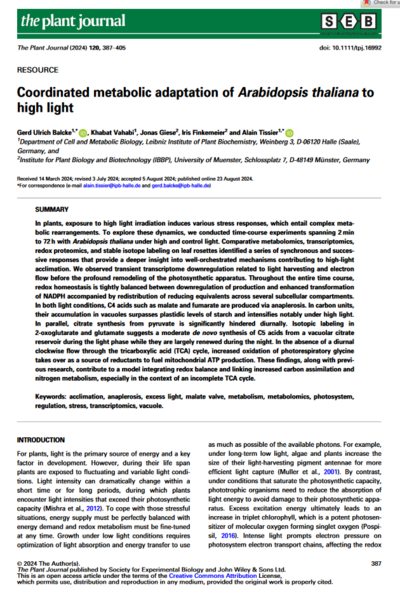Omics insights into plant resilience to light stress.
Intense light conditions stress the plant as they increase the formation of reactive oxygen species (ROS) in cells, which damage molecules critical for biological functions. Plants respond to this photooxidative stress with various adaptations.
Scientists from IPB Halle and the University of Münster have now gained a comprehensive overview of these high-light-induced adaptive responses in Arabidopsis thaliana. For that, they used a multi-omics approach, including transcriptomics, redox proteomics, and metabolomics.
The analyses were conducted over a time frame from 2 minutes to 72 hours after the transition from normal light conditions to high light. Additionally, the researchers labeled carbon dioxide (CO₂), the carbon source of photosynthesis, with a ¹³C isotope, allowing them to trace metabolic fluxes under high and normal light conditions.
Obtained by using state-of-the-art experimental approaches, the results offer valuable insight into photosynthesis and metabolic arrangements in plants coping with excess light conditions. Photosynthesis, which takes place in the chloroplasts of illuminated plant cells, produces energy-rich nutrients from light energy and carbon dioxide. Under high light, it runs the risk of accumulating excess electrons in form of the reduction equivalent NADPH, which can in turn promote ROS formation.
Concerted metabolic flux re-arrangements counteract this in several ways. At the transcriptional level, within seconds, components of the photosynthetic light-harvesting complexes are downregulated, while factors that prevent over-reduction are upregulated within minutes. At the metabolic level, photorespiration, a side reaction of photosynthesis that consumes oxygen, is intensified. Increased photorespiratory activity under excess light, however, appears to also distribute excess electrons from oversaturated photosynthesis to other cell compartments, thus protecting the plant cell from redox imbalance and ROS damage.
In parallel, large quantities of C4 acids (malate, fumarate) accumulate in the vacuoles under high light. In terms of molar carbon, the amount of these acids even exceeds the amount of starch stored in the chloroplasts. This way, plants employ an alternative mechanism to store excess energy in form of reduced carbon.
This increased formation of C4 acids is actually surprising, as de novo synthesis of C5 and C4 acids via the citric acid cycle is nearly inactive during the light phase. With this daytime carbon flux compromised, two key questions arise: How are such large amounts of C4 acids generated? And how is mitochondrial activity sustained under high light? Metabolomics provided the following answers: Firstly, increased photorespiratory activity yields glycine, which fuels mitochondria with carbon and NADH. And secondly, C4 acids are formed from triose bodies via a reductive route by the enzyme phosphoenolpyruvate carboxylase (PEPC).
Furthermore, the researchers observed an accumulation of numerous specialized metabolites - again, in a timely concerted manner. Within the first 24 hours, Arabidopsis leaves increasingly produce light protectants such as anthocyanins or tocopherols, compounds known to quench ROS activity. Not before 48 hours of continuous high light intensity, levels of carotenoids, xanthophylls, and plastoquinones rise, while transcriptional downregulation of light harvesting complexes is de-repressed, suggesting a restructuring of the photosynthetic light-harvesting apparatus under long-term light stress.
The team of authors recently presented the results in The Plant Journal as a Resource Article. While individual plant responses to light stress are well studied, this study offers the first comprehensive assessment of these responses under consistent experimental conditions, providing an updated view of plant photosynthesis.
Original publication:
Balcke, G.U., Vahabi, K., Giese, J., Finkemeier, I. and Tissier, A. (2024), Coordinated metabolic adaptation of Arabidopsis thaliana to high light. Plant J, 120: 387-405. https://doi.org/10.1111/tpj.16992



